The McKinsey Leadership Project—an initiative to help professional women at McKinsey and elsewhere—has distilled a leadership model comprising five broad and interrelated dimensions: meaning, managing energy, positive framing, connecting, and engaging. Our September 2008 article “Centered leadership: How talented women thrive” describes the model. This new article reports results of a survey we undertook to learn how executives act on these dimensions. Read the article, then join our online conversation.
To further explore the centered leadership model, McKinsey recently asked senior and midlevel executives of both genders from around the world to respond to a series of questions that ask how they think about—and how they act on—each of the five dimensions.1 The survey shows that many executives at all levels and in organizations of all kinds, sizes, and locations often behave in ways that reflect the dimensions of the model. The findings also support the idea that these five dimensions—when executives apply them all at once—are associated with higher satisfaction and self-reported career success, regardless of their title, tenure, or gender.
Among the detailed results are that female respondents, on the whole, are more satisfied with their jobs than men are, a counterintuitive finding likely related to the fact that we surveyed working executives and did not include the much publicized group of women who have opted out. The findings also show that many executives intuitively do the right things to make themselves stronger leaders, though fewer consciously think about these topics.
Satisfied executives do more
Respondents to this survey were asked to agree or disagree with statements that explore their mind-sets and behaviors along the centered-leadership dimensions. The higher the score, on a scale from 1 to 6, the more likely they are to consciously think about or actively behave in a way that supports one of the five dimensions. We aggregated the responses to individual questions into overall views on mind-sets and behaviors. The survey shows that, on the whole, executives are thinking about and/or acting on all of the dimensions, with meaning being the dimension cited most frequently (Exhibit 1). Overall, nearly 60 percent of all respondents say they are satisfied or extremely satisfied with their jobs; notably, women are somewhat more likely than men to be satisfied (Exhibit 2). It is important to note that female respondents to this survey are all working executives; women who have “opted out” of paid work—a hotly debated group, at least in the United States—are not represented.
Multidimensional leadership
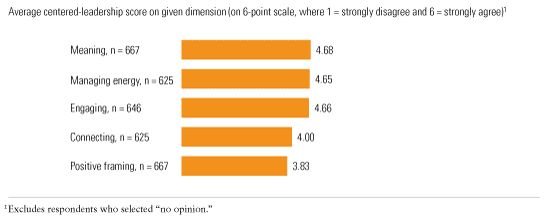
More job satisfaction among women
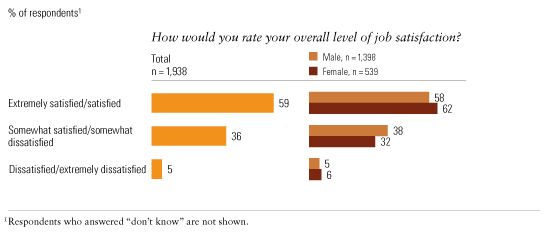
Further, executives who manage the most people—100 or more—are the most satisfied of all: 72 percent say they are highly satisfied, regardless of title or tenure. Married executives and those with two or more children are also more satisfied in their careers than others, which may reflect other widely reported findings that married people are in general happier. Apparently, having more children does not lead to distress at work for these respondents, despite the obvious balancing act it requires.2
Highly satisfied executives score higher than less-satisfied executives on four of the five dimensions of the leadership model; the difference is negligible only in positive framing (Exhibit 3). Satisfied women score even higher than satisfied men across all of the dimensions, which is consistent with the finding that women also practice centered-leadership skills more often than men (Exhibit 4).
Higher scores for satisfied executives
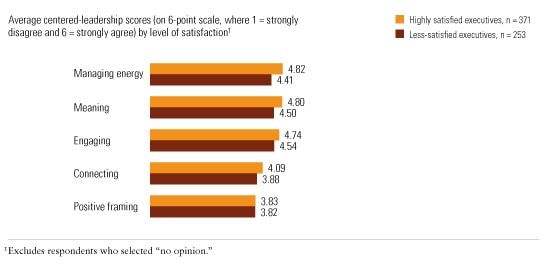
More centered leadership by women satisfied with their jobs
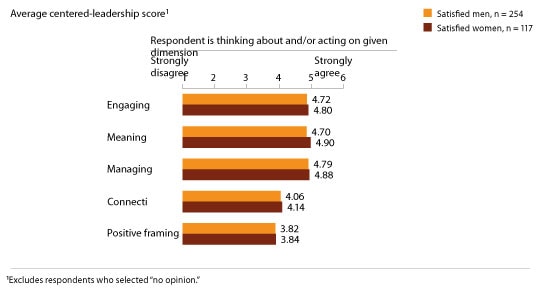
Executives who manage the most people also score higher on all five dimensions than those who manage few (Exhibit 5). The biggest differences between these executives’ scores and others’ fall under managing energy and connecting, dimensions that are most deeply related to working with other people. It may be that these executives are in their positions because they have both more resilience and better skills with people than others or, conversely, have developed those skills in order to cope with leading large numbers.
Higher scores for senior managers
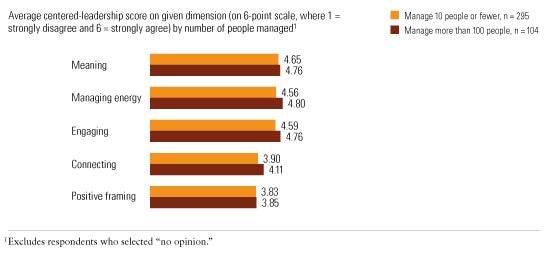
How senior executives differ
C-level executives are far more likely than others to find meaning and satisfaction in their work; two-thirds say they are highly satisfied, while just 43 percent of midlevel managers say the same.
On the whole, however, there are few differences between C-level executives and others, perhaps because people don’t necessarily get better at building these skills over time—like any other skill, the survey suggests, these must be cultivated. The older an executive is, for example, the more likely he or she is to both think about and actively practice the skills involved in engaging and finding meaning in work. Still, older executives are less likely to focus on managing energy and on connecting—suggesting a loss of mentorship opportunities and guidance in developing people more generally.
Thought versus action
Overall, executives are more likely to take action on all dimensions than to think consciously about the importance of each (Exhibit 6). However, it is notable that the most dissatisfied executives say they think more than they act on the dimensions of meaning and managing energy. This pattern suggests that more satisfied executives may have intuitively mastered many of the skills that are associated with career satisfaction.
Less thought, more action
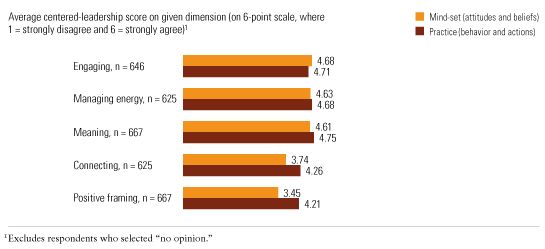
Looking ahead
-
The relatively low overall scores on framing and connecting suggest that many executives might improve their job satisfaction by focusing on these areas. Since people tend to learn new behaviors only after they realize they need them, raising awareness of these skills could be the right place to start.
-
Satisfied executives are more likely to be thinking about and acting on all of the dimensions of centered leadership at the same time suggesting that executives who do the same will benefit.
-
For companies, the finding that satisfied female executives undertake all of these leadership behaviors even more frequently than their male counterparts do may suggest that programs to build women’s skills in areas like networking could be less important than structural programs to address women’s access to opportunity. However, for companies seeking to retain more women, it would also be important to know whether the women who opt out of the workforce have a different view of centered-leadership skills than these survey respondents do.
How are you putting the elements of centered leadership to work? We invite you to join an online conversation exploring the ways that executives put these elements to use in their lives and careers.